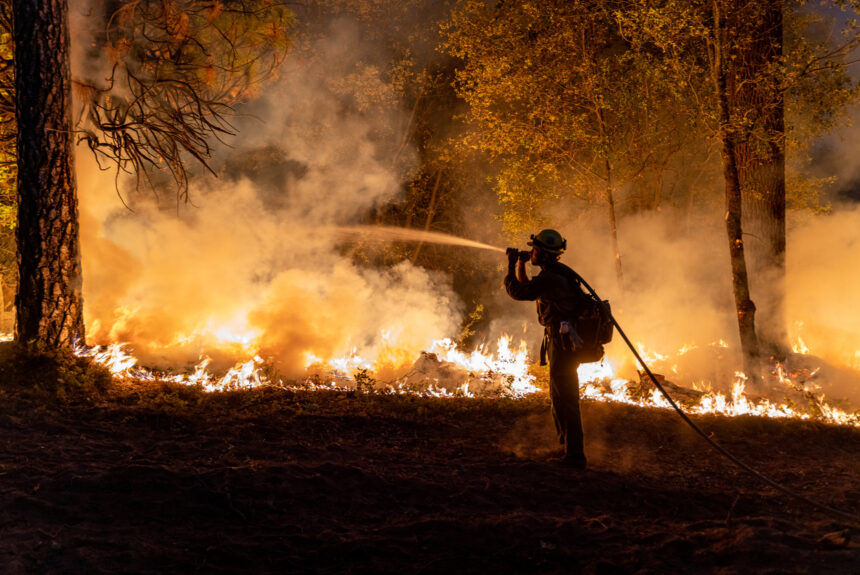In the past year, artificial intelligence (AI) has grown exponentially and become essential to daily life. From writing reports to selecting music queues in Spotify, AI is making daily tasks more streamlined. AI is also being used to help address larger and more complex issues such as wildfires, which have become more intense and frequent in North America in recent years. Several startups have entered the space in an effort to save lives, reduce wildfire damage, and preserve our natural environment.
>>>READ: Can this Green Aviation Startup Deliver Truly Clean Flying?
In the fields of ecology and forestry, AI is being utilized to develop next-generation technology that can identify wildfires in its tracks, before they wreak havoc. One pioneer in the field is California “firetech” startup Pano AI, which uses an artificial intelligence technique known as “object detection” to catch blazes in their infancy. Pano relies on a network of high-resolution 360-degree mountaintop cameras to capture data that is evaluated by an algorithm for any signs of smoke. The algorithm is powered by deep learning, which allows it to instantaneously identify, verify, and sort out wildfire events in real time (the software has been trained to distinguish between smoke and non-smoke imagery). When the algorithm detects a potential threat, fire monitoring professionals are automatically alerted to review the imagery and control for false positives. Once a flame is confirmed, first responders are quickly summoned to the scene. In essence, the entire system is streamlined to enable a swift and assertive response from all actors along the wildfire management chain.
Pano already has an agreement with Washington’s Department of Natural Resources (DNR) to install 21 fire lookouts in high-risk areas across the state by the end of June. Each “station” will contain two continuously rotating, smoke-detecting cameras that will be monitored by Pano’s staff in an intelligence hub. In tandem with satellite data, Pano’s connected intelligence platform will serve as a first line of defense against wildfires.
“As soon as smoke or heat is detected on the landscape, our fire managers can direct air and ground suppression forces to the source in record time. It also means more time for nearby communities to receive information from emergency services and act quickly if evacuations are required,” Hilary Franz, commissioner of Public Lands for Washington DNR, said in a press release about the upcoming pilot program.
Other predictive AI technology is being spearheaded by companies like Munich-based OroraTech. Orora specializes in satellite-based wildfire monitoring. Using advanced satellite sensors and round-the-clock satellite imagery, Orora scans its environment for signs of ignition. Thermal-infrared cameras on the satellite locate points of interest and search for thermal radiation or areas with abnormal heat signatures. The collected information is then processed by “fire-detecting” algorithms specialized in identifying potential hotspots. Ground-based sensors relay the data to the respective authorities within seconds (as opposed to 90 minutes–a critical time frame when it comes to preventing deadly blazes).
>>>READ: A Burning Issue: The Economic Costs of Wildfires
According to Orora engineer Christian Molliere, Orora’s 24/7 constellation of 20+ nanosatellites was key to fighting the 2023 Chile wildfires that raged across the central and southern parts of the Latin American country last February.
In addition to the Chilean government, Orora has secured a multi-million dollar contract with the European Space Agency (the equivalent of NASA) to deliver valuable thermal data to the European Union.
Orora is not alone. Amsterdam-based Overstory similarly applies AI to satellite imagery to prevent wildfires and power outages. The firetech startup partners with utility companies to assess the wildfire hazard posed by vegetation adjacent to power lines, flagging only the most pressing insights. Its customers include Swedish outdoor power products manufacturer Husqvarna, Switzerland’s national railway company “SBB,” and the Rainforest Alliance, an international NGO.
Another European startup, Berlin-based Dryad Networks, employs AI sensors in the forest and the Internet of Things (IOT) technologies to “sniff out” megafires before they spread. Back in California, Parallel Flight Technologies leverages unmanned drones to fight bushfires.
As climate change extends droughts and fire seasons, communities around the world have become more susceptible to the impacts of wildfires. Artificial intelligence is creating ways to save lives, reduce damage, and preserve our ecosystems.
Nathalie Voit is a freelance content creator and a graduate of the University of Florida. She is an alumni of The Heritage Foundation’s Young Leaders Program.
The views and opinions expressed are those of the author’s and do not necessarily reflect the official policy or position of C3.
